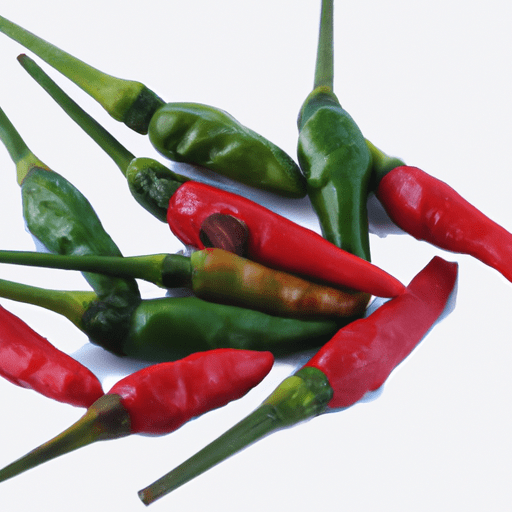Spicy, Flavorful, and Nutritious: Exploring Bird’s Eye Chilis
If you’re a spicy food lover or someone who enjoys experimenting with flavors in the kitchen, you must have encountered bird’s eye chilis. These small, fiery peppers can elevate any dish with their intense heat and unique taste. Join us as we dive into the world of bird’s eye chilis and discover their origins, culinary uses, nutritional benefits, and fascinating facts.
A Fiery Flavor Explosion
Bird’s eye chilis, scientifically known as Capsicum annuum, are small peppers that pack a punch. Named after their resemblance to a bird’s eye, these chilis are typically 2-3 centimeters long and come in various vibrant colors, such as red, green, and yellow. What sets them apart is their remarkable spiciness, rating an impressive 50,000 to 100,000 Scoville Heat Units (SHU).
Despite their intense heat, bird’s eye chilis possess a distinctive flavor profile. They offer a fruity, slightly citrusy taste that adds complexity to any dish. When combined with other ingredients, their natural heat blends harmoniously, imparting a fiery yet balanced sensation.
Versatility in the Kitchen
One of the reasons why bird’s eye chilis are highly cherished by cooks worldwide is their versatility. These fiery peppers find their way into an array of culinary creations, adding an unforgettable kick. Here are a few notable uses:
1. Asian Cuisine: Bird’s eye chilis are a staple in many Southeast Asian dishes. From Thai curries to Vietnamese pho and Indonesian sambal, they provide the signature heat that elevates these cuisines to new heights.
2. Hot Sauces: Many hot sauces owe their heat to bird’s eye chilis. The combination of their spiciness and distinct flavor makes them ideal candidates for creating complex and addictive condiments.
3. Pickling: Due to their small size and vibrant color, bird’s eye chilis are perfect for pickling. The briny and spicy result is a delicious accompaniment to various dishes, such as sandwiches, tacos, and salads.
4. Marinades and Rubs: Bird’s eye chilis, whether fresh or dried and ground into a powder, are often included in marinades and rubs. They infuse meats and vegetables with a mouthwatering heat and deliver a depth of flavor that is truly remarkable.
Health Benefits Galore
Besides their culinary merits, bird’s eye chilis offer numerous health benefits, making them a worthy addition to your meals. Here are some of the advantages:
1. Rich in Vitamins: Bird’s eye chilis are packed with vitamins A and C, essential nutrients that support a strong immune system, healthy skin, and good vision.
2. Antioxidant Powerhouse: These chilis contain potent antioxidants, such as capsaicin, which help protect against oxidative damage and promote overall well-being.
3. Metabolism Boost: The spiciness of bird’s eye chilis can temporarily increase your metabolic rate, aiding in weight management and promoting fat oxidation.
4. Pain Relief and Mental Clarity: Capsaicin has been linked to pain relief and improved cognitive function, potentially offering benefits beyond the culinary realm.
A Dash of History and Fascinating Facts
As we explore the world of bird’s eye chilis, it’s intriguing to learn about their history and some lesser-known facts:
1. Origin: Bird’s eye chilis originated in South America, specifically from the Amazon region. From there, they spread across the globe, becoming a culinary treasure in many cultures.
2. Global Names: These chilis go by various names in different parts of the world, such as Thai chili, piri-piri, kung pao chili, and peri-peri chili, reflecting their impact on regional cuisine.
3. Scoville Scale: With a Scoville rating ranging from 50,000 to 100,000 SHU (or even higher), bird’s eye chilis are significantly spicier than jalapenos, offering an intense heat that ignites the taste buds.
4. Handle with Care: When handling bird’s eye chilis, exercise caution, as their potent heat can cause skin irritation. Wearing gloves or thoroughly washing hands after handling them is advisable.
In Conclusion
Bird’s eye chilis are a thrilling addition to any culinary adventure. With their fiery heat, distinct flavor, and various uses, they truly embody the mantra of “spice up your life.” Whether you’re exploring vibrant Asian cuisines, experimenting with homemade hot sauces, or seeking to boost your health, these tiny peppers are guaranteed to leave a lasting impression. Embrace the heat, tread lightly, and embrace the flavorful wonders of bird’s eye chilis in your next gastronomic escapades.
Bird’s Eye Chili
Origin: Bird’s eye chili, also known as Thai chili, is native to the tropical regions of Southeast Asia. It is commonly found in countries like Thailand, Indonesia, Malaysia, and the Philippines.
Common Uses: Bird’s eye chili is widely used in various cuisines to add heat and spice to dishes. It is a popular ingredient in Thai, Indonesian, and Malaysian cuisine, where it is used in curries, stir-fries, sauces, soups, and marinades. It is also used to make spicy condiments like sambal and chili paste.
Nutritional Benefits: Bird’s eye chili is low in calories but packs a powerful nutritional punch. It is an excellent source of vitamin C, providing more than four times the amount found in oranges. It also contains other vitamins such as vitamin A, E, and B vitamins, as well as minerals like potassium and iron.
Unique Properties: Bird’s eye chili is known for its intense spiciness. It ranges from 50,000 to 100,000 Scoville Heat Units (SHU) on the Scoville scale, making it much hotter than jalapeños. The high capsaicin content in bird’s eye chili is responsible for its fiery heat. It also has a distinct fruity and somewhat floral flavor.
Historical Significance: Bird’s eye chili has been an integral part of Southeast Asian cuisine for centuries. It has been used not only for its flavor but also for its medicinal properties. In traditional medicine, it has been used to treat various ailments, including arthritis, digestive disorders, and even as a natural insect repellent. Additionally, the chili’s pungent properties are believed to increase metabolism and stimulate endorphin production.




Use the share button below if you liked it.
It makes me smile, when I see it.